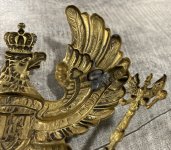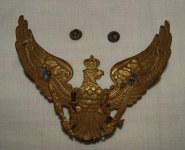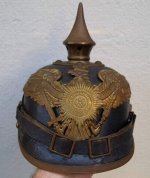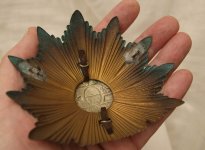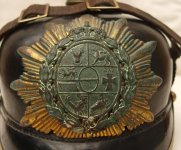At the end of “Casques à Pointe et Coiffures Prestigieuses de l’Armée Allemande. 1842-1918 » (vol. 1), Jean-Louis Larcade wrote a section entitled « En matière de faux ». I have translated it in English as I thought it might be of interest for the members of this forum:
“About fakes...
Between WW1 and WW2, at the exception of a few prestigious examples, headgear of old german armies had practically no value at all. German helmets were not sought after, at the exception of a handful of collectors who probably looked quite weird to their fellow militaria collectors. We have been able to meet several of these old-timers who, for almost all of them, made the same comment: “When I did not possess the spike helmet from a small state but I had the correct plate, I built it up with another helmet, without bothering about regimental markings”. This is how forgery started, with no evil intent since these early collectors had no will to sell their production. Available items were countless, and demand was almost null since amateurs, in the years 1920-1940, collected almost exclusively pre-1871 French militaria. Then, in the 1960’s, the price of german headgear started to increase linearly until 1970. From then on, prices litterally exploded, ruining the dreams of many people with limited funds who just collected for the fun of it.
Purchasing spike helmets became an investment for a new class of “knowledgeable amateurs”… who were in fact only concerned with the trade value of these objects, and who started buying anything, regardless of the price, as long as it was shiny and flashy. This new trend was particularly obvious at auctions. The most famous one took place at the end of 1970, and caused prices to double in one day. Incredible put-together fakes (the French slung word is “bidouille”; it is impossible to translate litterally but the meaning is extremely pejorative…) sold for small fortunes. To mention but one, a claimed prussian Leib-Gendarme helmet, a spectacular and exceptionally rare item, made an extremely high price; it was in fact a fake built from a 1867 prussian cuirassier helmet! And people fought to purchase such a thing!
We have seen the first plate reproductions at the St Ouen flea market (a major flea market located in Paris northern suburbs) in 1966-1967. These were likely made from original models but the maker probably did not have a strong enough press since the finish was very poor. These were all made of brass and attachments could only fool laypeople as they were made of screws of “ISO” thread size. Matching nuts were neither square or hexagonal but round… On guard eagles, the star that should be made of white metal was made of grossly silvered brass and soldered to the eagle.
At the same time, virtually all fittings of the 1895 model spike helmet were also made new, as well as stars, rear spines and chinscales for officer helmets.
Other plates reproduced by galvanoplasty are easily identified after inspection of the back.
The quality of these fakes then increased significantly and a second generation arrived from Germany. Surprisingly, these were sold as copies in Germany but crossing the border was giving them full authenticity. On enlisted plates, attachments were now the expected brass loops but their ends were folded inside, and not outside as on authentic plates.
All of the spectacular officer helmet plates with enameled centers are also made new (one sees, for example, so many pre-1912 IR92 helmets of the Ist and IInd batallions!!!) but the enamel is usually not very crisp, nor does it have the exact color of old plates.
Even parade eagles for Garde du Corps and Garde Kurassier helmets have been copied for at least 10 years but all fake examples we have seen have a feature that allows to spot them readily as copies: the eagle is of the enlisted type but it is mounted on an officer-type clover leaf basis.
Beware also of false regimental markings, which often look amazingly authentic. However, a rag impregnated with 90° alcohol usually readily makes the difference!
To conclude this long “gibernage” (impossible to translate: this exotic word qualifies a passionate conversation between militaria collectors), our last word is to advise the most extreme caution when you purchase helmets. We wish you good luck, dear fellow collectors!”.
And this was written 23 years ago…
Bruno
“About fakes...
Between WW1 and WW2, at the exception of a few prestigious examples, headgear of old german armies had practically no value at all. German helmets were not sought after, at the exception of a handful of collectors who probably looked quite weird to their fellow militaria collectors. We have been able to meet several of these old-timers who, for almost all of them, made the same comment: “When I did not possess the spike helmet from a small state but I had the correct plate, I built it up with another helmet, without bothering about regimental markings”. This is how forgery started, with no evil intent since these early collectors had no will to sell their production. Available items were countless, and demand was almost null since amateurs, in the years 1920-1940, collected almost exclusively pre-1871 French militaria. Then, in the 1960’s, the price of german headgear started to increase linearly until 1970. From then on, prices litterally exploded, ruining the dreams of many people with limited funds who just collected for the fun of it.
Purchasing spike helmets became an investment for a new class of “knowledgeable amateurs”… who were in fact only concerned with the trade value of these objects, and who started buying anything, regardless of the price, as long as it was shiny and flashy. This new trend was particularly obvious at auctions. The most famous one took place at the end of 1970, and caused prices to double in one day. Incredible put-together fakes (the French slung word is “bidouille”; it is impossible to translate litterally but the meaning is extremely pejorative…) sold for small fortunes. To mention but one, a claimed prussian Leib-Gendarme helmet, a spectacular and exceptionally rare item, made an extremely high price; it was in fact a fake built from a 1867 prussian cuirassier helmet! And people fought to purchase such a thing!
We have seen the first plate reproductions at the St Ouen flea market (a major flea market located in Paris northern suburbs) in 1966-1967. These were likely made from original models but the maker probably did not have a strong enough press since the finish was very poor. These were all made of brass and attachments could only fool laypeople as they were made of screws of “ISO” thread size. Matching nuts were neither square or hexagonal but round… On guard eagles, the star that should be made of white metal was made of grossly silvered brass and soldered to the eagle.
At the same time, virtually all fittings of the 1895 model spike helmet were also made new, as well as stars, rear spines and chinscales for officer helmets.
Other plates reproduced by galvanoplasty are easily identified after inspection of the back.
The quality of these fakes then increased significantly and a second generation arrived from Germany. Surprisingly, these were sold as copies in Germany but crossing the border was giving them full authenticity. On enlisted plates, attachments were now the expected brass loops but their ends were folded inside, and not outside as on authentic plates.
All of the spectacular officer helmet plates with enameled centers are also made new (one sees, for example, so many pre-1912 IR92 helmets of the Ist and IInd batallions!!!) but the enamel is usually not very crisp, nor does it have the exact color of old plates.
Even parade eagles for Garde du Corps and Garde Kurassier helmets have been copied for at least 10 years but all fake examples we have seen have a feature that allows to spot them readily as copies: the eagle is of the enlisted type but it is mounted on an officer-type clover leaf basis.
Beware also of false regimental markings, which often look amazingly authentic. However, a rag impregnated with 90° alcohol usually readily makes the difference!
To conclude this long “gibernage” (impossible to translate: this exotic word qualifies a passionate conversation between militaria collectors), our last word is to advise the most extreme caution when you purchase helmets. We wish you good luck, dear fellow collectors!”.
And this was written 23 years ago…
Bruno


